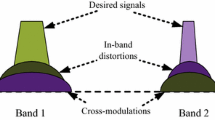Abstract
Compared with the traditional GPS L1 C/A signal, the existing and emerging new-generation wideband GNSS signals suffer more severe distortions due to the nonlinear characteristics of a high-power amplifier (HPA) in the satellite transmitter. HPA nonlinearity can lead to in-band signal distortion and out-of-band spectral regrowth, which degrade the ranging performance of a GNSS receiver. Researchers have reported power loss, correlation peak asymmetries, lock point bias as well as carrier tracking error caused by the HPA nonlinearity. However, few pre-distortion approaches that compensate for the HPA nonlinear effects have been presented in the GNSS field. We first take BDS-3 B2 asymmetric constant envelope binary offset carrier signal as an example to present the HPA nonlinear effects on wideband GNSS signals. Then, the design principle of a predistorter is investigated, and a Hammerstein predistorter is proposed to eliminate the nonlinear HPA with memory. Finally, we compare the constellation diagram, power spectrum, correlation function, code tracking bias with and without the Hammerstein predistorter. The comparison results demonstrate that a digital predistorter is a potential solution to compensate the HPA nonlinear distortions for wideband GNSS signals. This pre-distortion approach is of great significance that can effectively guarantee the nominal signal quality in space not only during the maintenance of the current GNSSs but also for the future emerging local or global navigation systems.












Similar content being viewed by others
References
Chen YB, Kou YH, Zhang ZW (2012) Analog distortion of wideband signal in satellite navigation payload. In: China satellite navigation conference (CSNC) 2012 Proceedings, Guang zhou, China, pp 89–100
Dafesh P, Cahn C (2009) Phase-optimized constant-envelope transmission (POCET) modulation method for GNSS signals. In: Proceeding of ION GNSS 2009, institute of navigation, Savannah, GA, September, pp 2860–2866
Dong SH, Taewon H (2000) An adaptive pre-distorter for the compensation of HPA nonlinearity. IEEE Trans Broadcast 46(2):152–157
Euns C, Powers EJ (1997) A new Volterra predistorter based on the indirect learning architecture. IEEE Trans Signal Process 45(1):223–227
Gilabert PL, Montoro G, Bertran E (2005) On the Wiener and Hammerstein models for power amplifier predistortion. In: 2005 Asia-pacific microwave conference proceedings, Suzhou, China
Guo F, Yao Z, Lu M (2016) BS-ACE-BOC: a generalized low-complexity dual-frequency constant-envelope multiplexing modulation for GNSS. GPS Solut 21(2):561–575
Harmon J, Wilson SG (2010) Remote satellite amplifier predistortion using the indirect learning architecture. In: The 2010 military communications conference, San Jose, CA, pp 335–340
Huang XF, Hu XL, Tang ZP (2009) Impact of satellite’s high power amplifiers on spectrum of navigation signals and PRN tracking accuracy. Acta Electr Sinica 37(3):640–645
Lei D, Zhou GT, Morgan DR, Ma ZX, Kenney JS, Kim J, Giardina CR (2004) A robust digital baseband predistorter constructed using memory polynomials. IEEE Trans Commun 52(1):159–165
Lei D, Raich R, Zhou GT (2002) A Hammerstein predistortion linearization design based on the indirect learning architecture. In: 2002 IEEE international conference on acoustics, speech and signal processing (ICASSP), Orlando, FL, pp 2689–2692
Lestarquit L, Artaud G, Issler J-L (2008) AltBOC for dummies or everything you always wanted to know about AltBOC. In: Proceedings of ION GNSS 2008, Institute of Navigation, Savannah, GA, September, pp 961–970
Li CH, Liu YX, Mo WH, Ou G (2013) Analysis of the impact of satellite’s high power amplifier on the performance of navigation signals carrier tracking. J Natl Univ Def Technol 35(2):81–84
Li X, Geng SM, Ou G, Zhuang ZW (2008) A study on PN code ranging error caused by nonlinear power amplifier. J Navig Univ Def Technol 30(5):49–55
Lu MQ, Li WY, Yao Z, Cui XW (2019) Overview of BDS III new signals. J Navig 66(1):19–35
Ma JJ, Yao Z, Lu MQ (2019) An efficiency optimal dual-frequency constant-envelope multiplexing technique for GNSS signals. GPS Solut 23:68
Raich R (2004) Nonlinear system identification and analysis with applications to power amplifier modeling and power amplifier predistortion. Georgia Institute of Technology, 2004
Soellner M, Kurzhals C, Hechenblaikner G et al (2008) GNSS offline signal quality assessment. In: Proceedings ION GNSS 2008, Institute of Navigation, Savannah, GA, pp 909–920
Soellner M, Kohl R, Luetke W et al (2002) The impact of linear and nonlinear signal distortions on Galileo code tracking accuracy. In: Proceedings ION GPS 2002, institute of navigation, Portland, OR, pp 1270–1285
Si X, Jin M (2011) A novel adaptive structure for Hammerstein predistorter. J Electr Inf Technol 33(6):1345–1349
Yao Z, Lu M (2017) Signal multiplexing techniques for GNSSs: the principle, progress, and challenges within a uniform framework. IEEE Signal Process 34(5):16–26
Yao Z, Zhang J, Lu M (2016) ACE-BOC: dual-frequency constant envelope multiplexing for satellite navigation. IEEE Trans Aerosp Electr Syst 52(1):466–485
Zhang JY (2018) Design and evaluation of gnss multi-carrier constant envelope multiplexing signal under non-ideal conditions. Dissertation, Tsinghua University
Zhu A, Brasil T (2002) An Adaptive Volterra Predistorter for the Linearization of RF High Power Amplifiers. In: 2002 IEEE MTT-S international microwave symposium digest, Seattle, WA, pp 461–464
Acknowledgements
This work is supported by the National Natural Science Foundation of China (NSFC) under Grant 61771272.
Author information
Authors and Affiliations
Corresponding author
Additional information
Publisher's Note
Springer Nature remains neutral with regard to jurisdictional claims in published maps and institutional affiliations.
Rights and permissions
About this article
Cite this article
Guo, N., Yao, Z. & Lu, M. Indirect learning Hammerstein HPA predistorter for wideband GNSS signals. GPS Solut 25, 6 (2021). https://doi.org/10.1007/s10291-020-01041-7
Received:
Accepted:
Published:
DOI: https://doi.org/10.1007/s10291-020-01041-7



